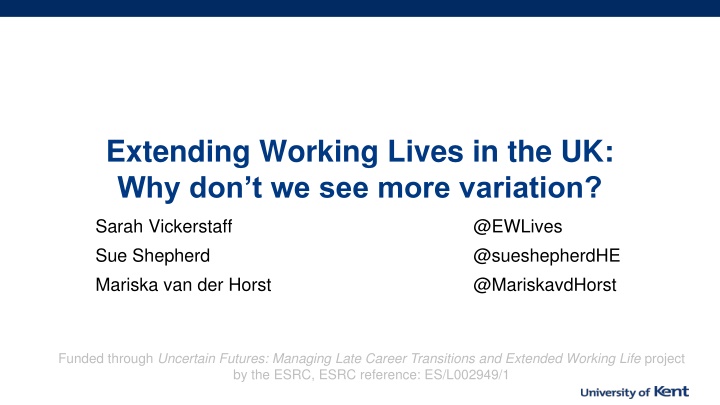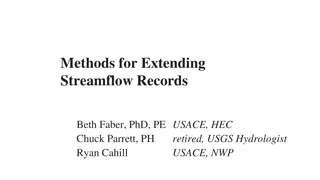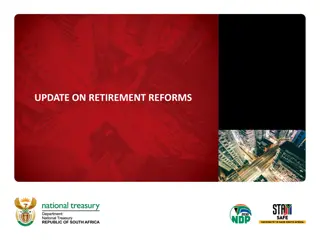
Variations in Extending Working Lives and Retirement Transitions
Discover the factors influencing the lack of variation in extending working lives in the UK, explore quantitative and qualitative research findings on retirement transitions, and understand the transition typology shaping late career choices.
Download Presentation

Please find below an Image/Link to download the presentation.
The content on the website is provided AS IS for your information and personal use only. It may not be sold, licensed, or shared on other websites without obtaining consent from the author. If you encounter any issues during the download, it is possible that the publisher has removed the file from their server.
You are allowed to download the files provided on this website for personal or commercial use, subject to the condition that they are used lawfully. All files are the property of their respective owners.
The content on the website is provided AS IS for your information and personal use only. It may not be sold, licensed, or shared on other websites without obtaining consent from the author.
E N D
Presentation Transcript
Extending Working Lives in the UK: Why don t we see more variation? Sarah Vickerstaff Sue Shepherd Mariska van der Horst @EWLives @sueshepherdHE @MariskavdHorst Funded through Uncertain Futures: Managing Late Career Transitions and Extended Working Life project by the ESRC, ESRC reference: ES/L002949/1
Tony Bennett I left my heart in San Francisco Most recent album in 2016, celebrating 90th birthday Quoted to say: I ll never retire Photo tom.beetz: CC BY 2.0 https://www.flickr.com/photos/9967007@N07/6582221 985
Extending Working Lives Policies to stimulate working up to / beyond State Pension Age Talk about new transitions , such as un-retirement, phased retirement, move into self-employment, etc. This presentation: evidence from quantitative and qualitative research
Quantitative research English Longitudinal Study of Ageing (ELSA), waves 1-6 Respondents aged 50-60 in first wave who participated in all six waves 2,286 respondents Sequence analysis followed by cluster analysis Mostly see single exit from labour market Little evidence for new transitions
Qualitative research Qualitative data complements and supplements the quantitative analysis Data is more recent (2015/16) giving a contemporary snapshot of employees retirement thinking following the abolition of a mandatory retirement and the equalisation of state pension ages Provides additional insight on what is happening inside organisations Examines intended as opposed to actual retirement transitions In some cases, individuals may be very uncertain about their future plans and more than one option may be under consideration These findings reflect a judgement about an employee s primary intended transition, according to following typology:
Transition typology Transition type Full Retirement Definition Cliff edge retirement from current organisation with no subsequent paid employment plans. This can be early (before 65) or on time (at 65) Continued employment in the current organisation in the same role and same hours beyond the age of 65 with no subsequent paid employment plans. This is a form of late full retirement Continued employment in current organisation with a reduction in hours or grade. This may be by means of a formal flexible retirement scheme (with pension drawdown) or individual negotiation Bridge employment on reduced hours following retirement from current organisation. This may be via self-employment or paid employment in another organisation (and in either a career or non-career role) Retirement from current organisation by an unretired employee who has already retired with a pension from another paid job and re-entered employment Extended Working Phased Retirement Partial Retirement Serial Retirement Retirement from the current organisation followed by unpaid employment Encore Retirement
Participant profile CASE STUDIES Number of Participants % Female % Blue Collar % Full Time % Occupational Pension Labour Turnover Major downsizing via VS/VER Local Government (LG) 37 54 13 92 78 Low 18 39 67 100 100 Transport (TR) Low for the sector Hospitality (HO) 22 64 54 73 86 Engineering & Manufacturing (MA) 26 19 12 100 100 Low
Transition intentions Transition type Full Retirement % Local Gov % Transport % Hospitality % Eng & Man* All 27 39 46 42 37 Extended Working 43 44 41 12 35 Phased Retirement 5 6 4 15 8 Partial Retirement 22 27 15 Serial Retirement 3 11 9 5 Encore Retirement * Intended transition type is unknown for one of these participants
Key Findings (1) Full, or cliff edge, retirement from current employer remains the norm (72%) 37% intend to fully retire early or on time (i.e. at the former MRA of 65) 35% the extended workers plan to work beyond 65 before full retirement Finance is the main reason given for having to work longer, though many enjoy their job or wish to keep working due to a strong work ethic/identity There is a striking gender difference in relation to extended working, with 47% of women compared to 25% of men intending to keep working in the same organisation and fully retire after 65 In many cases this is due to the increase in SPA to 66/67. Women are more reliant on SP since their occupational pension is often smaller due to a combination of part-time working, low wages and late entry into the scheme
Key findings (2) Only 8% plan to reduce their hours or grade in a phased retirement Although, when prompted, many more employees view this as attractive, few have actively investigated it. For many it is financially unrealistic and even for those who could afford it, it is seen as difficult to achieve in practice Only one employee is on a formal phased retirement scheme (Local Gov) 15% of employees are planning partial retirement via bridge employment. These are untypical participants, i.e. Local Gov employees applying for VER and highly-skilled and marketable professionals in Manufacturing Most employees are realistic about their chances of securing a sufficiently well-paid part-time job elsewhere in their 50s or 60s There are five unretired employees planning serial retirement and no one intending unpaid encore retirement
Conclusion Both quantitative and qualitative data show limited evidence for phased retirement, partial retirement/bridge employment or unretirement Job continuity, not change, is the main feature of later working life Evidence in case studies of employees intention to extend working life - more true for women than men Highlights gender asymmetry due to relative financial disadvantage Late retirement is usually only a bit longer (usually until SPA of 66/67) not Tony Bennett style Some constraints to late working: Finance Downshifting not practical or affordable Poor knowledge of/access to flexible working opportunities
Policy implications Greater buy in to the idea that people need to work longer or at least, less apparent resistance to it than formerly Good news for policymakers wishing to release the untapped potential of older women in the workforce But, policy assumption of greater flexibility in retirement (e.g. Cridland 2016) is not justified To facilitate phased retirement employers need to offer not just flexible working, but a formal phased retirement option with pension drawdown facility To increase partial retirement opportunitiesvia bridge employment requires a supply of suitable part-time jobs that are accessible to older workers
Thank you! Thanks to all the people involved with the project: Ben Baumberg-Geiger, Amanda Burns, Charlotte Clark, Joanne Crawford, Amanda Fahy, David Lain, Wendy Loretto, Chris Phillipson, Mark Robinson, David Wainwright, Andrew Weyman
Questions? Twitter: Own: Sue Shepherd Mariska vd Horst Website project: http://www.kent.ac.uk/extendingworkinglives/index.html Own: http://sue-shepherd.co.uk/ http://mariskavanderhorst.com/ Project: XtendingWorkingLives @EWLives @sueshepherdHE @MariskavdHorst






















